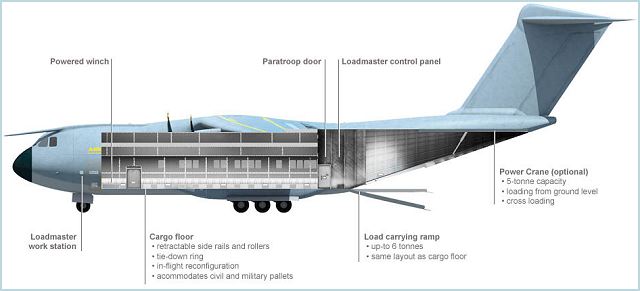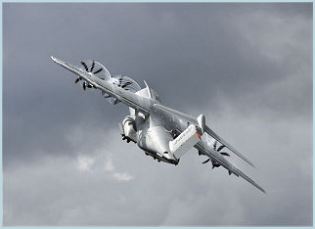A400M Airbus Military Transport Aircraft
| a | ||||||||||||||||||||||
|
A-400M Airbus Military transport aircraft
|
||||||||||||||||||||||
 |
||||||||||||||||||||||
|
The Airbus A400M is a multi-national four-engine turboprop military transport aircraft. It was designed by Airbus Military as a tactical airlifter with strategic capabilities. The aircraft's maiden flight, originally planned for 2008, took place on 11 December 2009 in Seville, Spain.The A400M, which is a collaborative venture involving the governments and industries of six European countries. The A400M is a larger, more modern, more flexible aircraft specifically designed to meet today’s requirements and indeed those of the future. The A400M can travel further and faster than most current in-service airlifters and can carry larger payloads. It is a multi-role transport, economical to operate, and exploits the benefits of state-of-the-art technology. The British armed forces is one of the future customer of A400M, it will support the deployment of the Joint Rapid Reaction Force and will give the British Royal Air Force a tactical and strategic-airlift aircraft capable of supporting all three services. |
||||||||||||||||||||||
| Variants | ||||||||||||||||||||||
|
The A400M will operate in many configurations including cargo transport, troop transport, Medical evacuation, aerial refuelling, and electronic surveillance.
|
||||||||||||||||||||||
| Technical Data | ||||||||||||||||||||||
| Design | ||||||||||||||||||||||
|
The Airbus A400M will increase the airlift capacity and range compared with the aircraft it was originally set to replace, the older versions of the Hercules and Transall. Cargo capacity is expected to double over existing aircraft, both in payload and volume, and range is increased substantially as well. The A400M's wings are primarily carbon fibre reinforced plastic. The eight-bladed Scimitar propeller is also made from a woven composite material.
|
||||||||||||||||||||||
| Avionic | ||||||||||||||||||||||
|
The two-pilot flight deck crew will have the benefit of an integrated, digital avionics system in the cockpit and a fly-by-wire control system. Additional systems will provide a night-vision-compatible glass cockpit complete with two head-up displays supported by at least five multi-function displays that will allow state-of-the-art avionics developments to be incorporated to the flight-deck design, so greatly reducing crew workload. A modern Defensive Aids Suite will be fitted, incorporating radio and infra-red frequency detectors, electronic-countermeasure equipment and chaff/flare dispensers. The EADS Defence Electronics defensive aids suite will include an ALR-400 radar warner from Indra and EADS, MIRAS (multi-colour infraRed alerting sensor) missile launch and approach warner developed by EADS and Thales, and chaff and flare decoy dispensers. A laser DIRCM (directed infrared countermeasure) system may be added later.
Thales and Diehl Avionik Systeme are developing the A400M's FMS400 flight management system, based on integrated modular avionics modules, an adaptation of systems being fitted on the Airbus A380 airliner. The avionics will include cockpit control and display systems with nine 6in×6in displays and a digital head-up display which features liquid crystal display (LCD) technology and enhanced vision systems (EVS), for enhanced situational awareness, automated CG calculation, automated defensive aids systems, simple EMCOM switching, simplified switching, uncluttered screens, automated tanker and receiver fuel control and auto fuel tank inerting. The aircraft's independent navigation system comprises an inertial reference system (IRS) integrated with a global positioning system (GPS). The weather and navigation radar is to be the Northrop Grumman AN/APN-241E, which incorporates windshear measurement and ground mapping capability. The radio navigation suite includes a pair of instrument landing systems, VHF Omnidirectional Radio ranging (VOR), radio distance measuring equipment (DME), air traffic control (ATC) transponders, automatic direction finders (ADF) and a tactical air navigation unit (TACAN). |
||||||||||||||||||||||
| Propulsion | ||||||||||||||||||||||
|
The A400M will be driven by four Europrop International (EPI) turboprop engines, which will be the most powerful turboprops developed to date in the western world, they will be lighter, easy to maintain and will consume 20% less fuel per mission relative to a similar turbofan engine. The A400M's normal operating speed is 555km/h, but it can reach a maximum speed of 780km/h. The normal and ferry ranges of the aircraft are 3,298km and 8,710km respectively. The service ceiling is 11,300m. The take-off and landing distances of the aircraft are 980m and 770m respectively. The aircraft weighs around 76,500kg and the maximum take-off weight is 141,000kg.
|
||||||||||||||||||||||
| Capability | ||||||||||||||||||||||
|
The A400M carries outsize loads such as helicopters, heavy engineering equipment and armoured vehicles that are too large or too heavy for current tactical airlifters.The A400M satisfies the fundamental requirement of recent humanitarian missions and today’s ongoing military operations to airlift heavy and large equipment directly to where it is most urgently needed, and thus enabling cost-effective and rapid response to crisis.
|
||||||||||||||||||||||
|
The A400M’s autonomous capability enables operations from remote austere airstrips.loaded/unloaded by a single loadmaster without assistance from ground. By minimizing time on the ground, the A400M’ systems reduces the aircraft’s vulnerability to hostile action. The Cargo Handling System allows for pallets and containers to be loaded/unloaded by a single loadmaster without assistance from ground.
All A400M could be rapidly re-rolled to become AAR tankers able to refuel fighters, helicopters and other large aircraft at those receivers’ preferred speeds and heights. No other tanker in service can do this. The A400M’s built-in AAR capability will give a commander operational flexibility by enabling him to assign these aircraft to whichever role is most needed to meet rapidly changing operational scenarios. |
||||||||||||||||||||||
 |
||||||||||||||||||||||
|
The A400M will be capable of carrying a load of 32 tonnes over a range of 2300nmls at speeds comparable with pure-jet military transports; furthermore, the range of the aircraft can be extended by the use of a removable, air refuelling probe mounted above the cockpit. The aircraft will be capable of operating either at low-level (down to 150ft agl) or at high-level altitudes to 11,300m, and it will be able to deploy troops and/or equipment between and within theatres of operation either by parachute (up to 108 paratroopers), or by landing on short, unprepared or semi-prepared strips. The aircraft will also offer significant improvements in reliability, maintenance and operating costs over the C-130K and J fleet. The cargo bay of the A400M will be controlled by one air loadmaster and can be configured for a number of roles: pure troop carrying, or a mixture of troops and support equipment; palletised cargo or military wheeled and tracked vehicles; two attack helicopters such as the Apache or Puma; or a mixture of light and heavy engineering equipment. Offloading equipment or stores after landing can be achieved using conventional ground equipment, the aircraft’s internal load-roller system, by airborne parachute or by gravity extraction from the aircraft’s rear ramp.
The A400M can also accommodate armour plating crew protection, bulletproof windscreens, engine exhaust treatment for infrared emission reduction, and inert gas explosion retardation and fire retardation in the fuel systems. The wings have hardpoints for the installation of electronic warfare pods and refuelling pods. |
||||||||||||||||||||||
| Specifications | ||||||||||||||||||||||
|
||||||||||||||||||||||
 |
||||||||||||||||||||||
|
||||||||||||||||||||||
|
a
|
||||||||||||||||||||||































